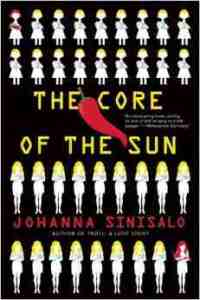The Core of the Sun by Johanna Sinisalo
 Monday, January 18, 2016 at 9:32AM
Monday, January 18, 2016 at 9:32AM 
First published in Finland in 2013; published in translation by Grove Press/Black Cat on January 5, 2016
The Core of the Sun mixes two themes, both involving a repressive Finnish government in an alternate Finland. The first theme addresses the limitation of individual freedom in the guise of promoting the social good (as the American government did during Prohibition). The second addresses the control of women by a male-dominated society. The result is an interesting, although occasionally heavy-handed, story that sometimes has a dated feel.
Government surveillance in this version of Finland is ubiquitous. Modern technologies like smartphones, available in decadent western countries, are outlawed in Finland. The government refuses health care to people who are judged to have lived unwholesome lives. Girls receive a limited education. They may not refuse an offer of marriage unless the suitor is a criminal or physically violent. This law protects the constitutional right of males to enjoy regular sexual activity and has a calming effect on society. Thus does female subjugation (restyled as “domestication”) promote social order.
The government “gender tests” children to specify their final gender. Then the government changes the child’s name and decides which girls can breed, selecting for traits that the government deems ideal (submissiveness, a desire to please, a youthful appearance, etc.), a process that serves as a form of genetic engineering. Social and cultural norms also shape approved female behavior, as do husbands who follow manuals that explain how to train a wife.
The testing and name change happened to Vanna (formerly Vera) shortly after her mother moved to Finland in the 1950s. Vanna was classified as a “femiwoman” or “eloi” (a name taken from H.G. Wells), but only because she sensed that she should play with the doll instead of her first choice, the fire truck. Vanna should probably be classified as a “neuterwoman” or “morlock,” a classification given to women who are excluded from the mating market. Pretending to be eloi when a woman is really a morlock constitutes the crime of gender fraud. On the other hand, Vanna’s sister Manna (formerly Mira) is a true eloi. Manna has been missing for some time, providing the story with an undercurrent of mystery.
If that background had been written in 1985, when Margaret Atwood’s The Handmaid’s Tale appeared, it would have seemed fresh and relevant. Now the premise seems derivative and comes a few decades too late to be taken seriously as a commentary upon gender oppression. The gender theme of The Core of the Sun might appeal to fans of dystopian fiction who are lingering in the past, but it won’t do much for readers who expect an innovative genre to be … innovative.
Fortunately, the second theme, and the story set against that background, is interesting, although very strange. Finland shuns “decadent democracies” that allow people to make their own health choices in favor of maximizing the power of the Health Authority. Cayenne peppers and other sources of capsaicin are illegal in Finland, along with alcohol, tobacco, and cannabis. The Health Authority classifies capsaicin as a nerve toxin and doesn’t want its citizens to develop a tolerance and seek hotter and hotter peppers. My brief internet research suggests that capsaicin raises endorphin levels and helps relieve the symptoms of opiate withdrawal, but outlawing jalapenos seems a little silly. It is, however, an interesting allegory for drug policies that limit the right to make choices about what drugs to take.
In 2016, Vanna is a capsaicin addict. Her friend Jare Valkinen (a “masco,” or masculine male) is a dealer. As an aggressive morlock disguised as a passive eloi, Vanna is in a position to feed her habit by helping Jare sell his peppers. Part of the plot centers on Vanna’s illicit activities. Another part focuses on the absence of Manna from Vanna’s life for reasons Vanna reveals in a series of letters that she writes but never sends. Another focuses on Gaian philosophy, which in this version of Finland has become focused on chili peppers (substituting Brother Chili for Mother Earth). Gaians are devoted to “bringing fire back to the people” – fire being chili peppers.
Some of the story is told from Jare’s point of view. The evolution of his thinking – his gravitation toward “decadence” as defined by the Finnish government -- is one of the book’s highlights.
I think The Core of the Sun is best read as a tribute to hot sauce. Abstract thinkers might view the story as a protest against governments that promote blandness because they know that bland people don’t ask much of their government. In the end, the manner by which Vanna discovers Manna’s fate is a bit silly, but it is true to the story, which demands a considerable suspension of disbelief from readers who doubt the power of the pepper. For all its flaws, however, I enjoyed the novel’s offbeat nature. I’m not sure it works as a cautionary tale, but it works as entertainment. Readers looking for more conventional dystopian fiction, however, might want to look elsewhere.
RECOMMENDED